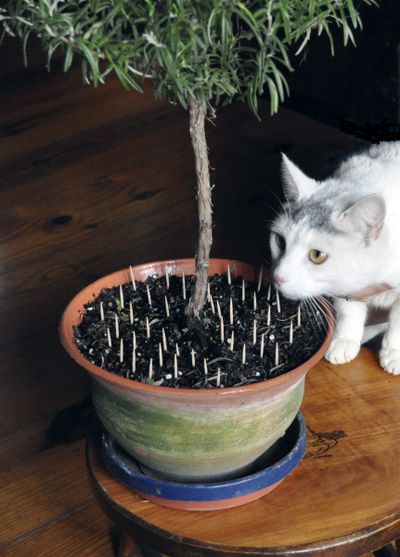Take care mixing cats, houseplants
Certain greenery can even prove dangerous

Cats like houseplants, but houseplants don’t like cats. Or, at least, cats don’t do houseplants any good.
Take my ponytail palm, for example. My cat is an outdoor cat, but I know that if she came indoors, what a grand time she would have jabbing her claws playfully at the ends of the palm’s wispy leaves. She’d do the same for my orchid’s flower stalk, now weighed down with a row of delicate blooms. Both plants would emerge from such play worn and frayed.
There’s not much you can do once a plant catches your cat’s fancy, except maybe get some mice to provide greater feline entertainment. A catnip-stuffed toy or a few stems from a kiwifruit vine — another favorite of cats — might also do the trick. (Various species of kiwifruit can be grown to yield delicious fruit almost anywhere.)
An appealing litter box
Cats’ horticultural trouble-making extends to flower pots filled with potting soil, especially fresh potting soil; they make attractive litter boxes.
Besides being offensive to us humans, a pot of soil used as a cat’s litter box is not good for the plant growing in it. Horse or other manure is great stuff outside in the garden, but a single cat working over a pot of soil … well, that’s just too much fertilizer for one plant. The roots will get burnt, perhaps to the point of killing the plant.
All sorts of tricks can keep cats from using flowerpots as litter boxes. Poking toothpicks vertically into the soil or spreading thorny stems, stones or seashells over the surface is sometimes effective. A barrier of wire mesh is 100 percent effective, as are barriers of plastic wrap or aluminum foil, but those barriers are unattractive, and you have to remove plastic wrap or aluminum foil each time you water.
Sometimes — just sometimes — temporarily thwarting your cat can get it permanently out of the habit of playing with a particular plant or using a flowerpot as a litter box. It’s important to provide other diversions, as well as romps outdoors or a nice litter box indoors.
Neither playthings nor food
Not only can cats be bad for houseplants, but some houseplants aren’t good for cats. Part of a cat’s frolicking, after all, involves chewing on, perhaps even eating, some greenery. This is natural: Cats, although carnivorous, do occasionally eat plants outdoors, either as is or in the intestines of the animals they eat.
Faced with a limited menu of indoor greenery, a housebound cat might be driven to some unwholesome varieties. Cat’s livers are relatively poor in dealing with toxins, and some houseplants have been known to kill cats. The most serious offenders are lilies and mistletoe.
Other common houseplants that might harm cats include dumbcane (dieffenbachia), philodendron and dracaena. Poinsettia, incidentally, has been exonerated as a culprit in poisoning either humans or cats.
If you suspect that a plant has poisoned your cat, contact your vet or the ASPCA National Animal Poison Control Center, www.aspca.org/pet-care/ poison-control.
Houseplants for cats
Providing appealing and healthful greenery indoors might be a workable alternative to getting rid of plants potentially toxic to your cat. Grown indoors, a pot of catnip is not much too look at, but your housebound cat would surely appreciate it. Other plants that might offer wholesome nibbles include dwarf marigolds or zinnias.
For something that looks nice and satisfies your cat’s palate, how about a pot or seedling flat of grass? Yes, grass. A miniature, indoor lawn for winter. Some fine-leaved sort such as Kentucky bluegrass or fine fescue. It’s cheap, it’s quick and easy to grow, and your feline friend can help keep it mowed by taking an occasional chew.